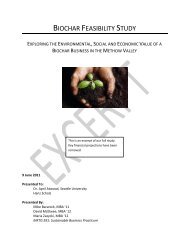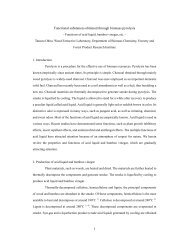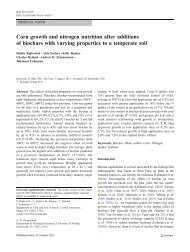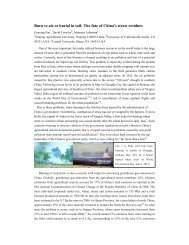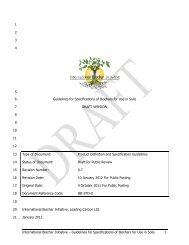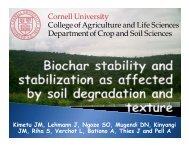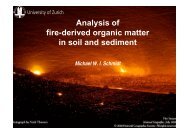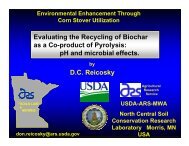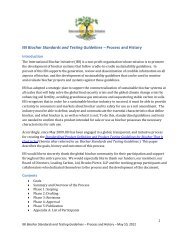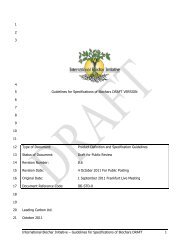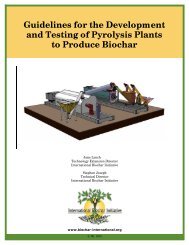Guidelines on Practical Aspects of Biochar Application to Field Soil ...
Guidelines on Practical Aspects of Biochar Application to Field Soil ...
Guidelines on Practical Aspects of Biochar Application to Field Soil ...
- No tags were found...
You also want an ePaper? Increase the reach of your titles
YUMPU automatically turns print PDFs into web optimized ePapers that Google loves.
Dr Mako<strong>to</strong> Ogawa <strong>of</strong> the Osaka Institute <strong>of</strong> Technology in Japan states that: “Makingcompost from litter and excreti<strong>on</strong>s has been comm<strong>on</strong> in Japan for a l<strong>on</strong>g time. In the1980s, charcoal compost was made from fresh chicken dung and palm shell charcoal; themore charcoal used, the faster the composting process. Under aerobic c<strong>on</strong>diti<strong>on</strong>s theBacillus group became dominant and produced antibiotics that inhibited growth <strong>of</strong> soilbornepathogens and suppressed root diseases. Charcoal compost is now sold in Japan asa biological fungicide. Various other organic composts are now being been produced fromlives<strong>to</strong>ck excreti<strong>on</strong>s and charcoal and sold commercially.” (Ogawa, 2009).Another example from Japan is bokashi, an organic fertilizer made by combining “effective”microbes, molasses, biochar, bran, and animal manure with water, and incubating underanaerobic or partially anaerobic c<strong>on</strong>diti<strong>on</strong>s (there are variati<strong>on</strong>s <strong>of</strong> this recipe and some d<strong>on</strong>ot include charcoal). This amendment was developed by the Japanese philosopher MokichiOkada in 1935 (Reap Canada), and is now made and used in many developing countriesaround the world, <strong>of</strong>ten incorporating native micro-organisms in additi<strong>on</strong> <strong>to</strong> the “effective”micro-organisms. The biochar can be made from any c<strong>on</strong>venient source <strong>of</strong> biomass, suchas sugar cane bagasse.Rice hull biochar is <strong>of</strong>ten used due <strong>to</strong> the availability <strong>of</strong> rice hulls in many regi<strong>on</strong>s.However, great care must be exercised while carb<strong>on</strong>izing rice hulls, as high processtemperatures can lead <strong>to</strong> the producti<strong>on</strong> <strong>of</strong> carcinogenic compounds. Rice hullcarb<strong>on</strong>izati<strong>on</strong> is routinely d<strong>on</strong>e <strong>on</strong> a variety <strong>of</strong> scales throughout the world, and processtemperature is very <strong>of</strong>ten unc<strong>on</strong>trolled, resulting in a potential health hazard. For moreinformati<strong>on</strong> <strong>on</strong> testing the safety <strong>of</strong> pyrolysis units, refer <strong>to</strong> IBI <str<strong>on</strong>g>Guidelines</str<strong>on</strong>g> for theDevelopment and Testing <strong>of</strong> Pyrolysis Plants, available <strong>on</strong> the IBI website.3.9 Meeting standards for Organic agricultureThe Nati<strong>on</strong>al Organic Program <strong>of</strong> the United States Department <strong>of</strong> Agriculture states thatbiochar is c<strong>on</strong>sidered a “n<strong>on</strong>-synthetic allowed” material, so l<strong>on</strong>g as it is made from plantbiomass and not animal manures, since ash from manure is prohibited. The use <strong>of</strong> “woodash” is also restricted for use <strong>on</strong> certified organic land by certain programs in the USA(Nati<strong>on</strong>al Sustainable Agriculture Informati<strong>on</strong> Service). AsureQuality <strong>of</strong> New Zealand lists“wood charcoal” and “wood ash” as requiring approval before use in certified organicagriculture (AsureQuality, 2010). In the province <strong>of</strong> Québec, Canada, the C<strong>on</strong>seil desappellati<strong>on</strong>s réservées et des termes valorisants (Council <strong>on</strong> reserved designati<strong>on</strong>s andvalue-added terms, which regulates organic certificati<strong>on</strong> agencies operating in theprovince) approves <strong>of</strong> wood charcoal as an amendment in organic agriculture.It is expected that with the rise <strong>of</strong> interest in and availability <strong>of</strong> biochar individualcertificati<strong>on</strong> agencies will start regulating biochar as a soil amendment in organicagriculture. Farmers should check with their certifying agency before using biochar. It isforeseeable that individual biochar products will require organic certificati<strong>on</strong>, given thelarge variability in biochar feeds<strong>to</strong>cks and characteristics.<str<strong>on</strong>g>Guidelines</str<strong>on</strong>g> for <strong>Biochar</strong> Applicati<strong>on</strong> <strong>to</strong> <strong>Soil</strong>—Internati<strong>on</strong>al <strong>Biochar</strong> Initiative Page 11



